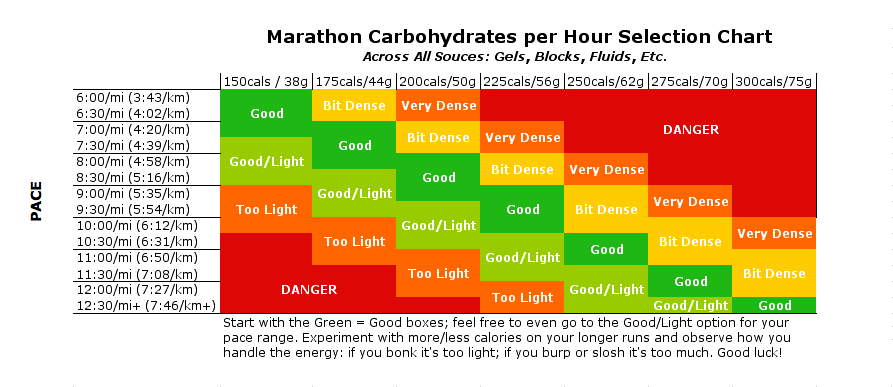Marathon Nutrition Protocol for Success

![]() photo credit: TimothyJThe period of time leading into your next marathon brings a lot of distinct challenges that are entirely unrelated to the race itself: tapering, traveling, eating, sleeping, etc. While important, these disparate elements don’t matter as much as the fitness you bring to the starting line and the plan you have in place to reach the finish line. Those two key factors aside, there’s one more element of your marathon day that will make or break your ability to reach the finish line on time–your nutrition. Few things are worse than having excellend fitness, a great plan, the perfect day to race and then watching it all fall apart because your nutrition failed. In this article, we’ll break down how to plan out your race nutrition plan given what’s available on the race course. Our goal is to help you create a simple, repeatable solution that makes fueling so simple that you forget about it. Please note: This is only about nutrition consumed while running, not day-to-day food guidance.
photo credit: TimothyJThe period of time leading into your next marathon brings a lot of distinct challenges that are entirely unrelated to the race itself: tapering, traveling, eating, sleeping, etc. While important, these disparate elements don’t matter as much as the fitness you bring to the starting line and the plan you have in place to reach the finish line. Those two key factors aside, there’s one more element of your marathon day that will make or break your ability to reach the finish line on time–your nutrition. Few things are worse than having excellend fitness, a great plan, the perfect day to race and then watching it all fall apart because your nutrition failed. In this article, we’ll break down how to plan out your race nutrition plan given what’s available on the race course. Our goal is to help you create a simple, repeatable solution that makes fueling so simple that you forget about it. Please note: This is only about nutrition consumed while running, not day-to-day food guidance.
Your Basic Fueling Needs
There are two main things you need to be concerned about when you run or race long: hydration and fuel. While most of us can run 60- or 90-minutes with only a little water, anything beyond that point without adequate calories will result in a very unpleasant–and likely sub-par–performance.
The Fuel
A marathoner can consume between 150 and 300 calories per hour. One gram of carbohydrates equals four calories, so the above range is between 38 grams and 75 grams. You should always start out low, adding fuel as you test your personal reaction to the calories. Remember it’s always easier to add a bit more at the next aid station than it is to “get rid of” excess food in your stomach! I’ll outline how you determine your position on this sliding scale in the next section of this article.
The Fluids
There really is no hard and fast guidance for this, especially with recent cases of hyponatremia (over-hydration). The basic protocol is to drink as frequently as you feel thirsty, and to help promote digestion of any fuel you are taking. On your longer runs this could mean taking a small drink every 10 to 15 minutes on a regular basis. On race day, this can be a simple as sipping fluids at every mile/aid station.
Outlining Your Personal Needs
Exactly how much you should consume per hour in a race like a marathon is a function of several factors: how long you will be out there racing, how “hard” you’ll be racing (intensity), the conditions of the race, and finally what you personally can eat with success. Use the Marathon Carbohydrates Per Hour selection chart to identify a starting point for your calories per hour. The chart works by syncing calories per hour based on your intensity level. The harder you are running, in general, the fewer calories you are able to consume. Conversely, the longer you will be out on the course (4, 5 or 6+ hours), the more calories you will need over time to continue your effort. The Green=Good label is the ideal place to start estimating your carbohydrate needs. The Light Green=Good/Light label is also okay, as it follows the “slightly lighter is better” approach, allowing you to add more nutrition as required. The Yellow / Orange / Red sections show how you move further out the carbohydrates/hour spectrum and at what point you might run into difficulty.
Testing Your Nutrition Plan
The chart above isn’t perfect, and some of you reading this will undoubtedly fall into an outlier position despite what I have experienced and seen coaching runners. Regardless, you won’t know what’s right for you until you actually test it out. In order to properly test your nutrition plan, you need several things to be lined up. First, you need a long run of at least 90 minutes on the schedule. Second, you need to map out exactly how many calories you will be taking in to cover the duration of the run. Third, you’ll need fluids to keep you hydrated and help you process the carbohydrates you are ingesting. Fourth, and final, you’ll need a rhythm in which to take your food. While everything else is simple, the rhythm is actually a critical part of how you’ll proceed. From a hydration perspective, you should be taking in some water every 10 to 15 minutes minutes (as you feel thirsty). Your nutritional rhythm depends on how many calories you are taking in and in what form. If you are opting for a gel form (easy to digest & carry), and you are looking at 200 calories per hour, then you can do:
- a 100 calorie gel every 30 minutes with water; water rest of the time.
- alternate water and 50 calories of sports drink every 15′, with a 100 calorie gel at the 45′ mark.
There is no one single right way to sync your fuel; create a plan and put it to the test in your next long run and then tweak it from there. You might need more water, fewer/more calories, different calories/flavors later in the day, perhaps even some caffeine to keep you sharp.
Your Nutrition Portability
Having nutrition is one thing; being able to take it with you is entirely different. Your plan is only as good as your ability to execute it, and odds are you long run route doesn’t have permanent aid stations manned with volunteers and ice water. As such you’ll need to plan out how to have access to your nutrition. Option #1: I personally use and recommend The Fuel Belt, and elegant solution for carrying your fluid and caloric needs on a long run or even race day. There are multi-bottle options with different packs and pockets to hold all your stuff…and it doesn’t bounce. You can learn more at www.fuelbelt.com and you can use the code MNation to save 20% off any purchase there. Option #2:Use your car as a central point and run out/back or a butterfly pattern route to get the miles in without getting too far from your car.
Course Resource Research
Once you have a basic plan and have tested it out over multiple long runs, then you can begin to formulate a plan for race day. Remember that each race is different in terms of aid station placement and what they offer at each station, so be sure to check the official website. Then you can head out to the store and pick up the items so you can begin to incorporate those specific items into your own rhythm. This is a critical part of your preparation as it will help you determine exactly what / how / when you’ll be fueling on the big day. Note that it might take one or two long runs for your body to “like” the different fuel source, so don’t give up on it right away! Finding your personal fueling pattern isn’t easy, but once you have built it out you can get down to the business of really racing and chasing your marathon potential. If you have any other tips or tricks, please share them in the comments below!


3 Responses to “Marathon Nutrition Protocol for Success”